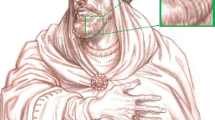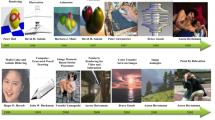Abstract
Enhancement can exaggerate visual details in both image processing and 3D rendering. In this paper, we adapt the gradient enhancement technique from image processing to 3D rendering through differentiating the rendering result with respect to the image space coordinates under point lighting. In this way, we can achieve 3D enhancement taking into account the gradient of geometry, projection transform, visibility and highlight. We also propose a tunable shape descriptor for users to achieve rendering results in different enhancement extent. Moreover, we extend this method to the environment lighting with some simplifications. Finally, we demonstrate that our method can handle the grazing angle area and the edges of sharp slope better than the previous method due to the gradient of the projection transform.


















Similar content being viewed by others
References
Ritschel, T., Smith, K., Ihrke, M., Grosch, T., Myszkowski, K., Seidel, H.-P.: 3d unsharp masking for scene coherent enhancement. ACM Trans. Graph. 27(3), 90 (2008)
Vergne, R., Pacanowski, R., Barla, P., Granier, X., Schlick, C.: Light warping for enhanced surface depiction. ACM Trans. Graph. 28(3), 251–258 (2009)
Saito, T., Takahashi, T.: Comprehensible rendering of 3-d shapes. ACM Trans. Graph. 24, 197–206 (1990)
Nienhaus, M., Dollner, J.: Blueprints—illustrating architecture and technical parts using hardware-accelerated non-photorealistic rendering. In: Graphics Interface, pp. 49–56 (2004)
Goodwin, T., Vollick, I., Hertzmann, A.: Isophote distance: a shading approach to artistic stroke thickness. In: Proc. International Symposium on Non Photorealistic Animation and Rendering (NPAR ’07), pp. 53–62. ACM, New York (2007)
Miller, G.: Efficient algorithms for local and global accessibility shading. In: Proceedings of the 21st Annual Conference on Computer Graphics and Interactive Techniques (SIGGRAPH ’94), New York, NY, USA, pp. 319–326. ACM, New York (1994)
Pharr, M., Green, S.: GPU Gems, Ambient Occlusion. Addison-Wesley, Reading (2004)
Cignoni, P., Scopigno, R., Tarini, M.: A simple normal enhancement technique for interactive non-photorealistic renderings. Comput. Graph. 29(1), 125–133 (2005)
Lee, Y., Markosian, L., Lee, S., Hughes, J.F.: Line drawings via abstracted shading. ACM Trans. Graph. 26(3), 18 (2007)
Zhang, X., Chen, W., Fang, J., Wang, R., Peng, Q.: Perceptually-motivated shape exaggeration. Vis. Comput. 26(6–8), 985–995 (2010)
Ihrke, M., Ritschel, T., Smith, K., Grosch, T., Myszkowski, K., Seidel, H.-P.: A perceptual evaluation of 3D unsharp masking. Proc. SPIE 49(0), 72400R–72400R–12 (2009)
Vergne, R., Barla, P., Granier, X., Schlick, C.: Apparent relief: a shape descriptor for stylized shading. In: Proceedings of the 6th International Symposium on Non-Photorealistic Animation and Rendering (NPAR ’08), pp. 23–29. ACM, New York (2008)
Vergne, R., Pacanowski, R., Barla, P., Granier, X., Schlick, C.: Radiance scaling for versatile surface enhancement. In: Proceedings of the 2010 ACM SIGGRAPH Symposium on Interactive 3D Graphics and Games (I3D ’10), New York, NY, USA, pp. 143–150. ACM, New York (2010)
Kindlmann, G., Whitaker, R., Tasdizen, T., Moller, T.: Curvature-based transfer functions for direct volume rendering: methods and applications. In: Proceedings of the 14th IEEE Visualization 2003 (VIS ’03), Washington, DC, USA, p. 67. IEEE Comput. Society, Los Alamitos (2003)
Lee, C.H., Hao, X., Varshney, A.: Geometry-dependent lighting. IEEE Trans. Vis. Comput. Graph. 12(2), 197–207 (2006)
Vergne, R., Pacanowski, R., Barla, P., Granier, X., Schlick, C.: Improving shape depiction under arbitrary rendering. IEEE Trans. Vis. Comput. Graph. 17, 1071–1081 (2011)
Ramamoorthi, R., Mahajan, D., Belhumeur, P.: A first-order analysis of lighting, shading, and shadows. ACM Trans. Graph., 26, January 2007
Vergne, R., Barla, P., Fleming, R.W., Granier, X.: Surface flows for image-based shading design. ACM Trans. Graph. 31(4), 941:1–949:9 (2012)
Koenderink, J.J.: What does the occluding contour tell us about solid shape? Perception 13(3), 321–330 (1984)
Gooch, B., Sloan, P.-P.J., Gooch, A., Shirley, P., Riesenfeld, R.: Interactive technical illustration. In: Proceedings of the 1999 Symposium on Interactive 3D Graphics (I3D ’99), New York, NY, USA, pp. 31–38. ACM, New York (1999)
Hertzmann, A., Zorin, D.: Illustrating smooth surfaces. In: Proceedings of the 27th Annual Conference on Computer Graphics and Interactive Techniques (SIGGRAPH ’00), New York, NY, USA, pp. 517–526. ACM, New York (2000)
DeCarlo, D., Finkelstein, A., Rusinkiewicz, S., Santella, A.: Suggestive contours for conveying shape. ACM Trans. Graph. 22(3), 848–855 (2003)
DeCarlo, D., Finkelstein, A., Rusinkiewicz, S.: Interactive rendering of suggestive contours with temporal coherence. In: Proceedings of the 3rd International Symposium on Non-Photorealistic Animation and Rendering (NPAR ’04), New York, NY, USA, pp. 15–145. ACM, New York (2004)
Ohtake, Y., Belyaev, A., Seidel, H.-P.: Ridge-valley lines on meshes via implicit surface fitting. ACM Trans. Graph. 23(3), 609–612 (2004)
Judd, T., Durand, F., Adelson, E.: Apparent ridges for line drawing. ACM Trans. Graph. 26(3) (2007)
Kolomenkin, M., Shimshoni, I., Tal, A.: Demarcating curves for shape illustration. ACM Trans. Graph. 27(5), 1571–1579 (2008)
DeCarlo, D., Rusinkiewicz, S.: Highlight lines for conveying shape. In: International Symposium on Non-Photorealistic Animation and Rendering (NPAR), August 2007
Belkin, M., Sun, J., Wang, Y.: Discrete Laplace operator on meshed surfaces. In: Proceedings of the Twenty-Fourth Annual Symposium on Computational Geometry (SCG ’08), pp. 278–287. ACM, New York (2008)
Zhang, L., He, Y., Xie, X., Chen, W.: Laplacian lines for real-time shape illustration. In: Proc. Symposium on Interactive 3D Graphics and Games (I3D ’09) (2009)
Gonzalez, R.C., Woods, R.E.: Digital Image Processing, vol. 1, 2th edn. Pearson Education, Upper Saddle River (2007)
Kajiya, J.T.: The rendering equation. ACM Trans. Graph. 20, 143–150 (1986)
Rusinkiewicz, S.: Estimating curvatures and their derivatives on triangle meshes. In: Symposium on 3D Data Processing, Visualization, and Transmission, pp. 486–493 (September 2004)
Debevec, P.: Rendering synthetic objects into real scenes: bridging traditional and image-based graphics with global illumination and high dynamic range photography. In: Proceedings of the 25th Annual Conference on Computer Graphics and Interactive Techniques (SIGGRAPH ’98), New York, NY, USA, pp. 189–198. ACM, New York (1998)
Ashikmin, M., Premože, S., Shirley, P.: A microfacet-based BRDF generator. In: Proc. SIGGRAPH ’00, pp. 65–74. ACM, New York (2000)
Acknowledgements
Many thanks to Romain Vergne et al. for sharing their OpenGL Shader source code, the anonymous reviewers for their valuable comments and Ming Zeng and Bo Jiang for proof reading. The testing scenes are courtesy of Stanford 3D Scanning Repository (Armadillo and Dragon). This work was partially supported by NSFC (No. 60970074), Fok Ying-Tong Education Foundation and the Fundamental Research Funds for the Central Universities.
Author information
Authors and Affiliations
Corresponding author
Appendix: The derivation of ∇n(x), ∇G Ph(x) and ∇ω i (x)
Appendix: The derivation of ∇n(x), ∇G Ph(x) and ∇ω i (x)
We take triangle meshes as the input data. Let T be the triangle that contains the point x. Denote the vertices of triangle T by x 0, x 1 and x 2. The barycentric coordinates, b v (x)=[b 0(x),b 1(x),b 2(x)]T, can be evaluated by

where |T| represents the area of the triangle, and n T is the normal of the triangle. Thus, we can interpolate the normal at point x by vertex normals N v of the triangle using the barycentric coordinates b v (x), and then normalize it as
where N v =[n 0,n 1,n 2] is the matrix of vertex normals.
Therefore, the gradient of the normal can be approximated by

The gradient of barycentric coordinates, ∇b v (x), can be evaluated by

As we have defined G Ph(x)=〈r(x),ω o (x)〉a, we can evaluate its gradient as

According to the definition of r(x) in Sect. 3.2, its gradient can be evaluated by

The derivation of ∇n(x) is given in Sect. 3.2. The gradient of ω i (x) and ω o (x) can be evaluated by

Rights and permissions
About this article
Cite this article
Zhao, F., Liu, X. 3D gradient enhancement. Vis Comput 30, 113–126 (2014). https://doi.org/10.1007/s00371-013-0787-3
Published:
Issue Date:
DOI: https://doi.org/10.1007/s00371-013-0787-3




